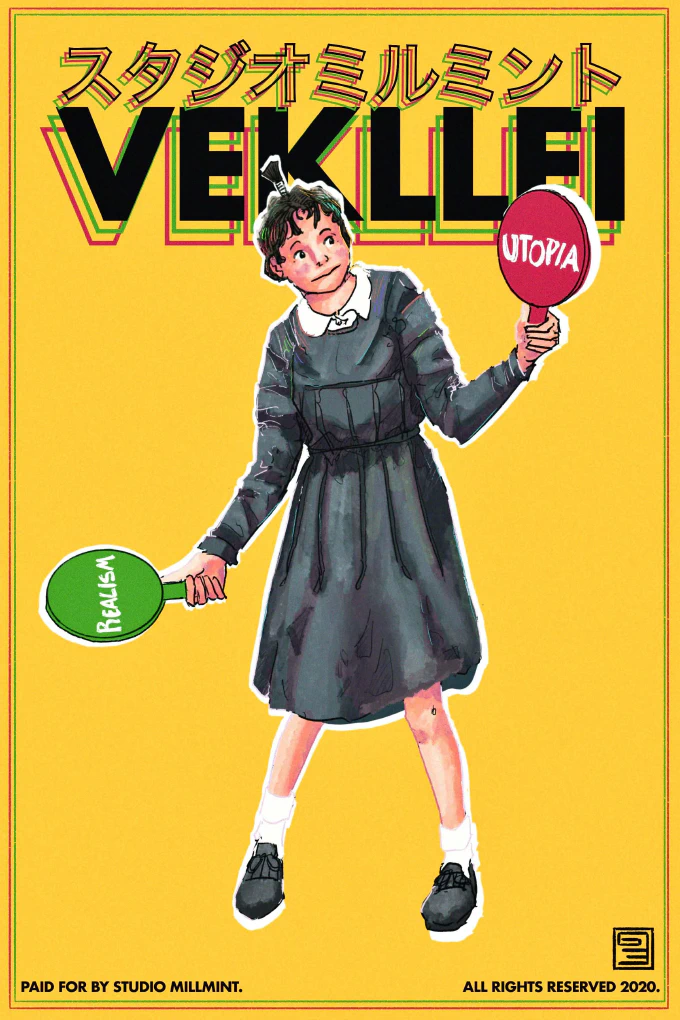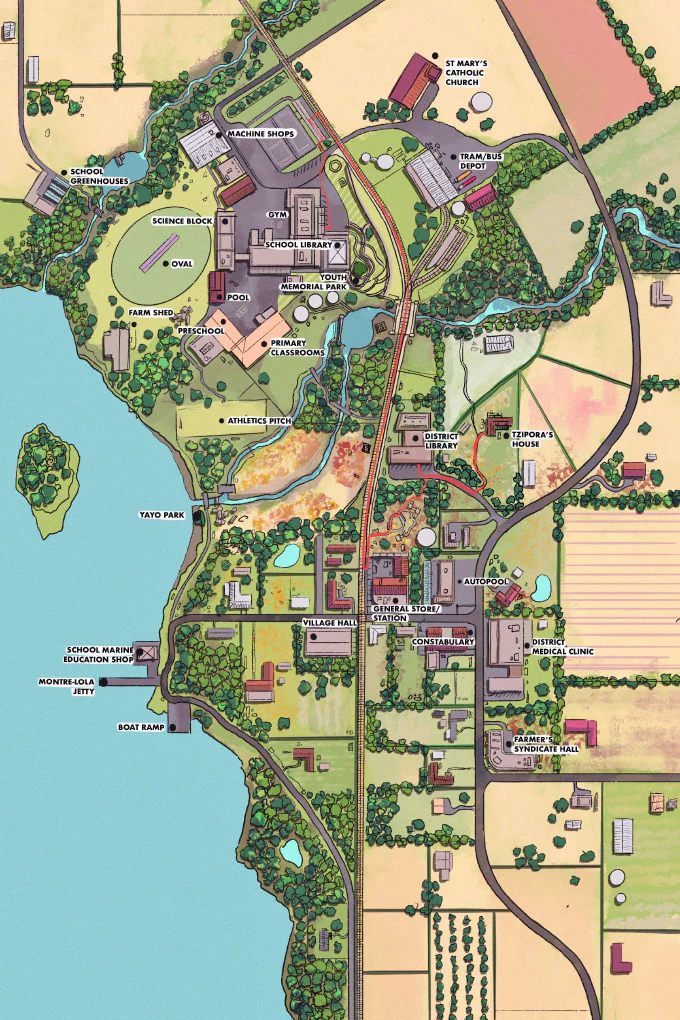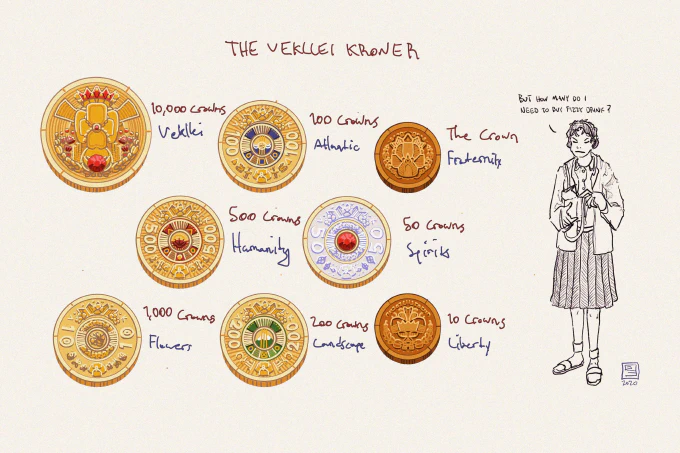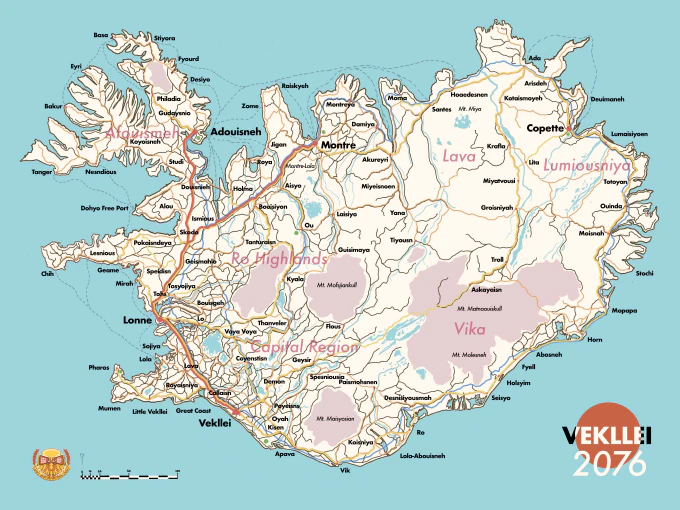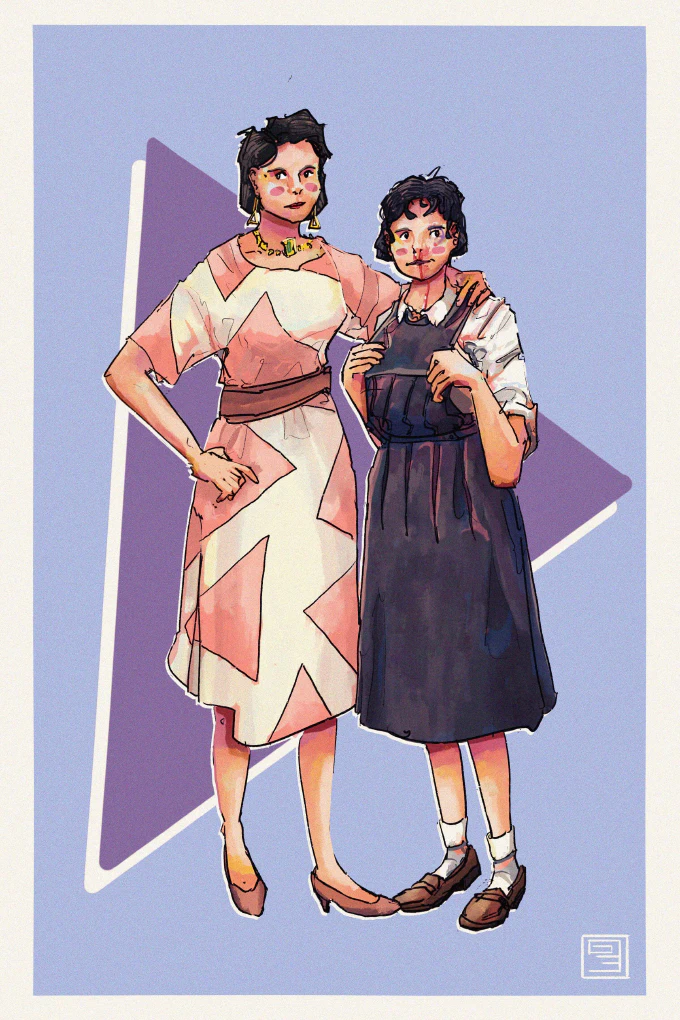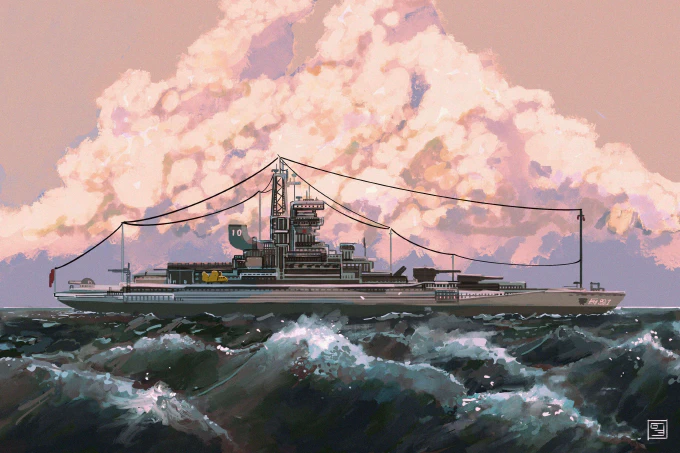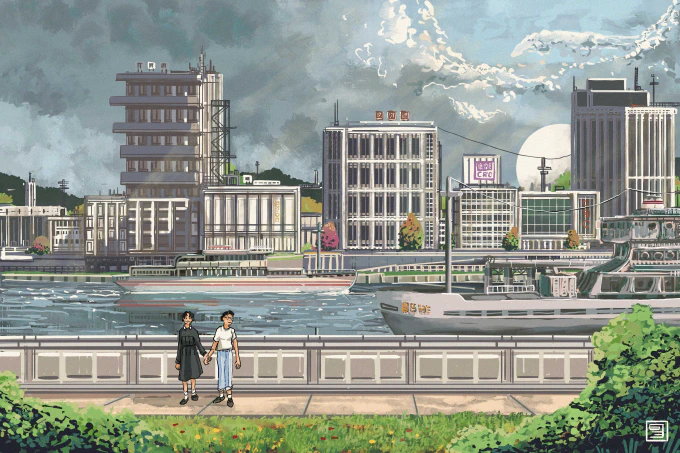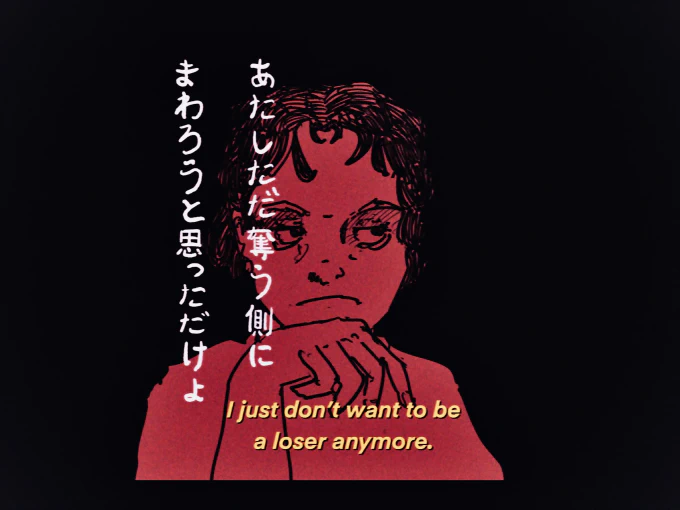NEW Story: Sunday Morning
The Atlantic Bulletin
From the Editor #
Welcome to the second issue of The Atlantic, closing a quiet month for the Petticoat Project that has ushered in several new beginnings. A comic; a new website; new friends — June was a good month. The posts this month departed from the slice-of-life conventions of May, reintroducing maps and infographics to the project. This is a good change! Look forward to more diagrams from Vekllei in future.
I’d also like to thank the contributors to this edition, Hangdog and Chev, for their essays. If you would like to contribute to The Atlantic with writing, art or reviews relevant to the spirit of petticoat ideology, please contact Hobart at [email protected] before the 31st of July.
Thank you for supporting Vekllei, and I hope you find value in this bulletin.
Hobart Phillips Enjoy — 楽しんで
I. News & Announcements #
- The postcard set for patrons is (just about) complete and awaiting the printers. I’ll contact patrons with a lifetime pledge of $20 or above for shipping addresses, and any patron who wants to make up the rest of their $20 for a set is welcome to do so.
- The Studio MillMint site is still under renovation. A lot of progress has been made in June, including a timeline page and the infrastructure required for a wiki and blog, but I’ve got so much going on at the moment that the site’s been relegated to “whenever there is time”.
- The comic has started in one form or another. It’s uni-related for now. Very soon I hope to be publishing storyboards of the “real deal” for patrons.
- Hobart’s uni break has started. Nice.
- Thank you always, patrons, for your continued support. It makes me feel loved, and lets me afford things like the postcards.
II. Tzipora-watch #
June 15th is Cobian’s birthday. It was on this day that Tzipora and Cobian first introduced themselves to each other, after Cobian’s ill-fated sweet sixteenth birthday party. Cobian was so struck with affection towards Tzipora and her friendliness that she was invited to a sleepover the following weekend.
III. Vekllei Fact of the Month #
You might be aware that puffins are Vekllei’s national bird — but did you know that some people keep them as pets? In coastal fishing towns, puffins make good friends. They’re curious, unafraid birds that keep their “pufflings" safe in burrows underground. Vekllei has the largest population of Atlantic Puffins in the world. They’re also rather tasty!
IV. WordBook #
Fiousmanyiosn — “friendly architecture”. This is a Newda term that describes architecture friendly to its surrounds. “Friendly,” here, means to integrate and socialise with a structure’s surrounds, by employing local materials and styles. It can also be “friendly” in its purpose — to provide a foundational service to a community, something important to cultural fabric. In this sense, Fiousmanyiosn refers to both a materials principle and cultural architecture.
V. The Bulletin #
What is This Project? #
📖 Published 30th June 2020 | Read here.
What is Vekllei?
Hi, I’m Hobart and I write and draw Vekllei at Studio MillMint.
This is a pretty complex project. Not just complex insofar as there’s a lot to read about it, but that it uses concepts and terminology you might not be familiar with if this is your first time around utopian fiction.
So Vekllei is a utopia — what does this mean? It’s latin for “no place,” and I use that literally. Vekllei, in a literal sense, cannot exist. Not because I think it could never have existed, or that some part of it is completely unreasonable, or it breaks the laws of physics — but because it exists in a certain place and time that is just isn’t replicable. It’s all built from the ground up.
Vekllei is a very good place to live, but it is not perfect. Utopia does not mean “perfect place”. Utopia is a form of social dreaming, much like worldbuilding, linked to the values and priorities of its author. In utopian studies, “utopia” is usually broken down further:
- Eutopia — “good place”
- Dystopia — “bad place”
Note that both form a part of the “utopia” — this is appropriate, since Vekllei is grounded in a social realism that acknowledges the good and bad parts of life. Indeed, they are inseparable — you cannot have the light without the dark. Obviously, in my eyes, Vekllei is very much a eutopia. You can read more about Vekllei (the country) by clicking here.
There are three parts to my “social dreaming”:
- Landscape — the world and country of Vekllei. When you think of “utopia,” this is it — shining modernist cities against striking landscapes.
- Character — not all social dreaming takes place in spaces. Some of it is built around experiences, objects and relationships. Tzipora is a “character utopia” in the sense that she represents a utopian life experience, full of stories good and bad.
- Author — Vekllei is a representation of the problems of my life, as a form of escapism. A lot of my posts here reflect dissatisfactions and displacements in my own life — consumer society, commodification of childhood, wage labour, postmodernism, etc. I’m very much a part of this utopian dialectic.
Let’s run through some of the common queries and misunderstandings about Vekllei
Who are you? A Tasmanian illustrator.
You’re not Japanese? お前はもう死んでいる
Why is Vekllei a utopia? It makes me feel better about my life and the world. It’s escapism; it’s a dream.
It’s a bit cringe to grandstand your political beliefs, doncha think? Vekllei is a personal utopia. That’s what I’m selling. At least you’re getting good opinions.
Where’s the tension if it’s perfect? Vekllei is very cynical and tragic in places. Utopia is just a reflection of the author, good and bad.
Is there a novel? A story? A comic? I’m working on a comic right now. I’m pretty much working on Vekllei full-time so I’m hoping to announce it soon. I’ve got a lot of different Vekllei projects going.
Where is Vekllei? Iceland.
Why does Vekllei look Japanese? Vekllei is like a country of Scandinavians speaking French with an Aussie accent in Shōwa era Japan/Maoist China/Taiwan etc. Vekllei looks however I imagine utopia looks.
How does that make sense? Why can’t it just be cool?
Is your alt-history thought out? Vekllei’s history is whatever I need it to be. I’m always trying to be realistic, but it’s all worked backwards from the setting. I’m not really “worldbuilding” in a typical sense. Very little of it is published, most of it is retrieved on request. Just ask if you have questions.
Is Vekllei communist? No.
But Vekllei calls itself “petticoat socialist”. Vekllei is set in a culture of Marxist revivalism in the 50s and 60s. A lot of Vekllei’s lexicon is set in that context. Vekllei is a decentralised democracy that doesn’t use money. It’s a sort of participatory economy.
Why the “petticoat”? Vekllei is a female country. Womanhood is decommodified. It’s maternal, social and friendly where socialist rhetoric is masculine, technocratic and progressive.
Who is Zelda? Zelda is another name for Tzipora. She has two names specifically to confuse you.
What is the “bulletin”? I publish the Atlantic Bulletin once a month via email. It’s got the month’s posts in it as well as facts and tidbits from Vekllei. DM me an email if you want to join.
Village Map of Montre-Lola #
📖 Published 29th June 2020 | Read here.
The village of Montre-Lola is home to about 400 people in its entirety, a stone’s throw from the Aisyo borough. Each morning, however, the population swells as 300 children from tiny villages in both Aisyo and Montre take a fast tram to the Montre-Lola Area School No. 2, a district school raising all ages of local youth.
Like many Vekllei villages, Montre-Lola’s history is complex and has origin stories in both viking-inuit settlement as well as less sentimental government programmes that flourished after the atomic war. By historical accounts, Montre-Lola has been inhabited since at least 1500CE. By contemporaneous records, however, it was established as a village in land reform during the 1960s and revitalised by the building of the area school in 2057. Montre-Lola features many civic objects common to Vekllei villages — a nondenominational place of worship (in this case, a historical Catholic church), a constabulary, a doctor, an auto/tractor pool, a general store, a station platform, and a village hall. A map of the village centre is dominated by the Area School, built in an Edunewda style, which features many new facilities that distinguish it from smaller, 20th-century schools. It’s a good place to grow up; where farmland and earnest modernity collide.
Montre-Lola is most relevant as the residence of Tzipora Desmoisnes, the world’s oldest person and one of the first people to be diagnosed with Gregori-Heitzfeld Syndrome. She works as a librarian in both the Montre-Lola Area School and the Montre-Lola Library & Archives, spending most of her 12-hour workday in either of these institutions. She commutes via fast trams, which arrive automatically at the two platforms in Montre-Lola every half-hour and continue out into the surrounding farms. This means that, if she sets her watch right, she can step outside her front door and arrive at the school library in under ten minutes. This journey is marked in red on the map above.
Dominated by farmland, Montre-Lola is communal and more traditionally ‘anarchist’ in flavour than Vekllei’s urban boroughs, which are obscured by convenience. As charming as it is suffocating, the community is very close-knit and made up of all sorts — smart educated young men and women sent from Montre to teach, as well as farming families that have resided here for centuries. Life moves slower and people know each other. When the school hosts its cross-country race each year, nearly every person in the village is out to watch it. After all, it takes a village to raise a child.
The Vekllei Crown: coins of a moneyless country #
📖 Published 24th June 2020 | Read here.
Vekllei, legendarily, does not use circulate currency. Goods and services are moved and offered arbitrarily, provided amply in abundance. Anything that is not abundant is manufactured and distributed directly under the control of a bureau, which is a trade organ responsible to the affairs of the country. At no point do coins or paper currency change hands in the day-to-day affairs of the country.
In this sense, Vekllei is usually described as “moneyless” — yet it does in fact have a currency. The Vekllei Kroner, or “Crown,” is hundreds of years old, and Vekllei still operates a mint for currency. At any time, a Vekllei person can write to the National Mint and order a set of coins, like the ones pictured above. So what is going on here?
Although the Kroner has not been used since 2022, after the last village in Stochi returned coinage to the Mint, it continues to exist to this day as a gold-backed currency in the International Market, through which Vekllei trades with other countries. The physical coins, produced mostly as a novelty in the tradition of mayaesdiou (medallions, or small metal pieces commonly collected and given in Vekllei), are a physical coinage of the International Market. The coins also operate as a form of bullion, or wealth reserve, since each coin is worth exactly its face value in gold. Since the International Market is completely closed and independent of the domestic economy, its value is controlled directly by the so-called Government Bank. It is one of the few gold-backed currencies in a developed nation today.
To further complicate things, there are actually two different Kroner in Vekllei. There is the Vekllei Kroner, which represents the International Market, but there is also a seperate Government/State Kroner, which is not minted and used only as an investment mechanism, backed by government “white bonds” which are usually measures of labour-hours or refined materials. It is, in a sense, a fiat currency alongside a gold-backed currency.
They exist independently because they are used for two seperate purposes. The Vekllei Kroner is used a wealth reserve and bullion, and also represents the collective wealth of the Vekllei people. Each citizen, in theory, is entitled to an equal share of the Government Bank, although it can only be withdrawn as currency in specific circumstances. Vekllei also holds substantial amounts of foreign currency in the Government Bank and Vekllei Kroner, which is used to invest and stabilise holdings and capital in foreign countries. The Government Kroner, on the other hand, is used as an investment mechanism abroad, usually in support of infrastructure. It is also used to acquire foreign currencies through investment in foreign capital.
Despite having two currencies, neither the “Vekllei Crown” or the “Government Crown” are used in the domestic economy in Vekllei, which is autonomous and not subject to a central bank. So it is that Vekllei’s currency is both little more than a novelty and essential to the function of the country in a world still ruled by money.
In the coinage depicted above — 8 coins are minted in Vekllei today. They were designed in 2015, in the year of independence. They represent eight core values in the country.
The “small crowns,” worth 1VK and 10VK respectively, represent fraternity and liberty, two founding elements of the Vekllei constitution. The 50VK coin is plated in silver and has a small ruby inset. Rubies are used to represent energy, in this case, the vitality of the spirits, which dominate Upen and the Vekllei landscape. The 100, 200, 500 and 1,000VK coins represent different landscapes of the country. As a volcanic island nation, the ocean (100) and landscape (200) coins are fairly straightforward. The humanity coin (500) represents the Vekllei people and ancestry — note how humans are placed alongside other natural forces. The flower coin (1,000VK) represents the flowers of the country, which are important spiritually and have formed part of the Vekllei identity. Vekllei has the most flowers per capita in the world. The final, larger 10,000VK coin represents the previous seven together, as a total sum of Vekllei landscape and identity.
To answer Tzipora’s question — a bottle of fizzy drink cost about 2VK in the waning days of coinage in the early 2020s.
A Map of Vekllei: 100 Boroughs; 100 Hearts #
📖 Published 14th June 2020 | Read here.
Map Key
Red: Magjet trains, 750km/h
Yellow: Bullet trains, 300-400km/h
Orange: Regional trains, <150km/h
Brown: Local trains, including limited express, <100km/h
Blue: National highway
Dashed: Ferry line
Green: tarmacadamed airport
The largest division of any portion of Vekllei land is the borough; a region of varying size and population with common culture, food dependency and economic interest. Anything larger than that is simply Vekllei — they are “one city”, after all, and consider themselves a city-state.
There have been exactly 100 boroughs since 2015. Each is named after the largest city in its region.
- The smallest borough is Bakur, in Afouismeh, with a population of 7,500 people.
- The largest is Vekllei proper, in the Capital Region, of 2.4 millions.
This transit map illustrates all 100 boroughs, Vekllei’s five tallest mountains, its permafrost glaciers and Tzipora’s home in Montre-Lola. Her five largest boroughs — namely Vekllei, Lonne, Adouisneh, Montre and Copette, are highlighted.
Even in this simple transit map we can see several truths about the country, like its population bias on the West Coast and the emptiness of the Lava volcanic region. You might recognise a few names there, like Lola in the West (Tzipora’s home with Baron) and Yana in Vekllei’s Ro Highlands (Ayn’s birthplace).
Trains are clean, reliable, fast, efficient and safe. They are incorporated under Vekllei Rail, owned by the Transport Group Bureau. Using this map, designed for domestic tourists and foreigners, the adequacy of Vekllei’s rail transport is easy to plan around — you can eat breakfast in a cafe in the seaside town of Mumen, and hike before midday on the glacial slopes of Askayoisn. Since there are no tickets or costs, there are no excuses for not visiting relatives in the country, now that transport is now a trivial inconvenience.
Each borough is represented in Vekllei’s parliament by an elected representative. These representatives wield extraordinarily disproportionate power — the representative for Callaisn, for example, represents hundreds of times more people than the representative for Tanger, but both have the same vote. This is because boroughs are not just representative of their populations, but also their environments, industry and other social organs otherwise unable to vote. It is important to keep in mind that Upen (and consequently, policy) recognises the landscape itself as the sovereign organ of the country, and so in this sense it has its own interests and projections.
In practice, representatives act in an advisory, nonpartisan role in government, voting rarely in an auxiliary role to the professionalised, elected legislature. Vekllei has a strictly constitutional parliament, and the economy largely prohibits interference. In this sense, the parliament is both partially undemocratic in its inefficiency and apolitical in its orientation as a sort of civil service bureau, managing state affairs and reacting to pressures and the long-term aims outlined in the 2015 constitution. In the Vekllei mindset, the “government” is more or less another bureau, no different or particularly more interesting than the Transport Group Bureau. The trains, at least, have a tangible impact on their daily lives.
How appropriate, then, that this transit map produced in the summer months of 2076 combines both monuments of society. It also offers a glimpse of a larger, documented country not necessarily revealed in piecemeal story posts.
A Most Beautiful Woman #
📖 Published 12th June 2020 | Read here.
When Tzipora first laid eyes on Ayn, hours after her arrival in the country, she thought, “that’s the most beautiful woman I’ve ever seen.”
It wasn’t just her features or figure that captured Tzipora’s attention — it was also her confident, inconspicuous movements and a quiet self-assuredness that seemed obvious in her gentle expression and posture. Tzipora was not quite sure how to describe it. Her beauty was very alive in the way she inhabited a space, as she walked into the hotel lounge to meet them. Maybe it was grace — maybe it was a little girl-crush — she didn’t know.
As Baron greeted her and they exchanged cheek kisses, it appeared to Tzipora that Ayn and Baron were old friends, and she was further assured in her respect for him — that Baron could know such beautiful women seemed natural! Baron was capable of anything in Tzipora’s eyes, a figure of ultimate power — it only made sense that he knew this woman!
Of course, both Ayn and Baron were mortal, and Tzipora got to know them well during the helter-skelter weeks following her arrival in Vekllei. Baron might have rescued her, but it was Ayn who introduced her to Vekllei, as AB/NI called Baron into office for the first time in a decade. It was Ayn who took her clothes shopping and wrestled with Zelda’s obsessive-compulsive fabric requirements. It was Ayn who taught Tzipora her first Vekllei sentence. And in the end, it was Ayn who convinced Baron that he had to take responsibility for Tzipora.
It was only years later that Tzipora began to realise that Ayn and Baron were, in a sense, married to each other through their work. They worked closely (he as recent head of operations at AB/NI, she as a research analyst in American economics) and their friendship went back decades. She was his “work wife,” which was the closest Baron could ever get to that particular institution, and so her proximity and love towards Tzipora made her a mother.
She was a vision of everything Tzipora wanted for herself — to be capable and respected; beautiful and unassuming; intelligent and productive. And once more, it was Ayn, in the end, who convinced Tzipora that she could these things for herself, regardless of her genetic disability. “Go out there,” is what she said, “and trust in yourself.”
The Oa-Class Battlecruiser #
📖 Published 6th June 2020 | Read here.
Vekllei’s defensive military posture has, in doctrine and arms development, limited its ability to meaningfully project power outside of the Atlantic. As an island nation with a large and multifaceted naval armada, the Oa-Class Battlecruiser is the heart of her armed forces, as the flagship of her fleets.
Where U.S. doctrine places carriers offensively in the structure of its ship-groups, the Vekllei Navy is considerably more Soviet in its employ of carriers as primarily defensive air-bases to exercise sovereignty over her far-flung territories and island possessions. Oa-class Battlecruisers are notable as hybrid carrier-battleships, and feature a diagonal jetway with capacity for carrier-type naval jets (almost indistinguishable in the illustration above) and a variety of VTOL aircraft, which are common by the 2050s.
First built in the 2050s by the sprawling National Naval Arsenal (located on Vekllei’s Far East coast, close to the foundries that pour her iron), 12 Oa-Class Battlecruisers are in service in the 2070s. They carry heavy fission reactors built by bureau monopoly General Reactor, supplemented by a gas-turbine generator, as is standard on all Vekllei-built nuclear vessels. Her unusual serpentine funnel is characteristic of Vekllei’s navy, and is a distinguishing feature of their naval design language.
Her hulking superstructure and massive 15-inch fore guns recall the capital battleships of yesteryear, but she is a thoroughly modern battlecruiser with contemporary armament and electrics for combat and fleet administration. Named after Vekllei’s National flower, these Battlecruisers are the third-largest vessels in the navy and are multifunctional by design, often operated as strategic and operational platforms to support Vekllei’s large defensive armadas that patrol the North Atlantic.
She is armed with two triple-barrelled 15-inch shore guns that can be loaded with a variety of shells including nuclear payloads, silos for guided missiles, and specialised guns and missile platforms for anti-ship, submarine and satellite warfare. Her powerful communications array and sensors are positioned 80 meters above the surface for the benefit of radar and subsurface monitoring. She can also support up to 12 standard carrier jets at one time, or 16 individual helijets/VTOL craft.
Vekllei has larger battlecruisers (the so-called super-battlecruisers match her height and are nearly twice her length) and much larger carriers, but the displacement of the vessel was never a priority. Vekllei’s naval architecture prioritises mobility and capability in their capital ships, and so the Oa-class vessels represent many intersecting vertices of Vekllei’s naval doctrine.
Canal Living #
📖 Published 3rd June 2020 | Read here.
Atlantic Salmon was the best in the world, and Vekllei had a lot of it. Ocean-going fishing boats brought their haul to Ro, where they cruised wide postwar canals and unloaded tonnes of shiny, bright salmon into processing plants. If a new factory was built, so too was a canal or a railroad. Nothing was trucked. Fish was traded fresh in markets or turned into emulsifiers and fertiliser.
The canals were worked heavily, and few fishing vessels were incorporated. The vast majority of Vekllei’s fishing fleet was owned by the people that worked them, trading with the Sea Office. From a quaisiosn or “canal park” you might see a dozen vessels in an hour. Some were run-down prewar things limping out to the shallow coasts, while others were nuclear-powered salmon trawlers designed for the storms of the Atlantic. On the northern coast, the bigger boats were reinforced as ice-breakers. Fish was one of the few meats in the Vekllei diet that wasn’t grown in an industrial laboratory, a fact reflected in the scale of its infrastructure.
Canals are good for a city, and are good for the heart. Tzipora would take long walks in the morning along the Wellington Canal to where it met Touismah, then follow it to where it circled back into Lola. She would figure out what she was doing with her life as the boats departed for the day’s catch. She never much liked salmon, but she liked the boats. They were an island country, and their futures and pasts met in the sea — where it churned and swelled in their dreams.
VI. The Post Office #
Aussie Thoughts on Police Violence [NEW] #
BY HANGDOG#4510
If you lived under a rock, you might be excused for missing the brutal murder of George Floyd. Unfortunately for you, America is the centre of all Earthly affairs, so the odds of the social media wildfire missing you are slim to none. But that’s okay, really, because at least it gives you something interesting to watch on the news, as a police station is torched or a wheelchair-bound hobo has his face blown open with a rubber bullet.
Can we Australians say we are better than Americans? Absolutely. You’re 27 times more likely to be executed by a police officer in the States than you are here. Roughly 25% of the world’s prison population can be found in the ‘land of the free’, and it seems every single protest has resulted in someone losing an eye or being knocked into tomorrow. But are we perfect? Fuck to the no. Earlier this month, videos surfaced of a police officer sweeping the legs of an Indigenous youth in retaliation for a few measly swears. Almost a third of our prison population are Aboriginal Australian, despite accounting for just over 3% of our general population. That sucks.
What are our possible solutions? Currently the popular rhetoric is radical and reactionary, with #ACAB and #AbolishThePolice signaturing every ‘woke’ Twitter or Instagram post. These reductionist slogans do hold merit; it’s not the individual that is evil, it’s the policing institution as a whole. Money that is spent inflating the budgets of corrupt police departments and outfitting riot squads with military-grade hardware could be better spent on community solutions. We need to elevate communities from the material poverty which leads to crime.
The question, then, is culture. Do we in the West have a social consciousness ready for community policing? Can we be sure that a decreased police presence will stop scenes like the Murray Hill Riots in Canada, where a police strike led to 16 hours of widespread looting? Can the West, and especially the Americans, really be trusted to govern themselves? This author thinks no. Excluding utopian socialist ideas that the root of all human evils is capitalism, tangible solutions are necessary.
It seems to be that the pragmatic approach is the strongest. Reforming police unions, holding officers accountable for crimes they commit on duty, and increase the standards necessary to wear the uniform and possess the badge. These sensible, attainable solutions would not only have immediate effects, but could have long term effects on American culture at large.
Reform however cannot perfectly address the root of the issue with the police. The police do and always will be the only entity to possess a ‘legitimate’ monopoly on violence. There is no use boring you in an anarchist breakdown of the monopoly on violence and the danger of hierarchies, because some dead revolutionary from the last century has put it better in some dusty tome. Simply put, any hierarchical enforcement of law will always justify the use of violence. The key is examining culture and society, and deciding on meaningful compromise between an ideological ideal and a pragmatic policy. We can negotiate between what is and what ought, but no solution will be perfect. Laws are by their very nature imperfect and malleable, bound not to a higher authority but to a cultural identity. The aim is not utopia, but to possess something that is better than what we have today.
Live to Ride: Harley-Davidson and the Commodification of Identity [NEW] #
BY CHEVALIERMALFET#1904
“The proof,” they say, “is in the pudding.”
If you ask a motorcyclist about Harley Davidson, you’ll get one of two answers. The people who don’t ride them scoff at them - heavy, dirty, clunky, and slow, Nixon-era dinosaurs inferior to both the Japanese standards and their own clones. If you ask a dedicated Harley rider, though, you get a different picture - they love their machines and their experiences riding them, and would never consider abandoning the company for a rival’s product. How has this company inspired such loyalty in spite of its terrible product?
Before I reach the point of this essay, fair is fair: Harley Davidson has an excellent customer service program and a wide network of dealers and mechanics. While this has nothing to do with the bikes themselves, it’s still a point in their favor.
But the main point is simple. A man who buys a Harley isn’t simply getting a new vehicle - he (and it is almost always he) is buying a new identity. Because of Harley’s tireless marketing, he has a very clear image of the sort of person who owns one. Every bike sold comes with a ticket to a new sense of self, and a new life as a “Harley Guy.”
Who is the “Harley Guy?” Who does this new rider imagine he’ll become? 60 years ago, the Harley image was bound up with real antisocial behavior. The first wave of bikers were WW2 veterans, shell-shock cases unable to return to civilian life, and their bikes were military surplus. Hunter S. Thomson’s Hell’s Angels describes the titular gang shooting heroin and smashing up gas stations.
But as the sixties wore on and the original bikers aged out or died off, Harley shifted its marketing. When its last domestic competitor went out of business, Harley wrapped itself in the flag and called itself the only choice for “Real Americans.” When Japan started selling small-displacement moped scooters, Harley touted its big bikes as the only choice for “Real Men.” When the automobile industry faced tighter safety regulations, Harley lobbied against helmet laws and called their buyers “Real Rebels.”
Combine it together and a picture emerges: the “Harley Guy” may be out of step with square society, but he’s still a member of it - and its enemies are still his enemies. He might rebel against the rat race and the nanny state - especially when they want him to wear a helmet - but that’s because he’s channeling the purest essence of America, the cowboy spirit of an imaginary past. He salutes the troops and supports the police, and he always stands up for the national anthem. Most of all, he is a member of a group - the Harley brotherhood, a community of like-minded individuals.
For most of the 80s, the American government protected Harley-Davidson with crushing tariffs. But those tariffs expired in 1988, and Harley was forced to fight the Japanese on even terms. Fighting bike-to-bike was impossible; the four Japanese OEMs were lean, mean, and honed to razors after 40 years of competition. Instead, Harley tripled-down on the marketing. The dealerships are apparel-shops, where customers can buy logo-branded shirts, bags, shot-glasses, and travel checkers sets. It has never been easier to show your identity - and your membership in the corporate family.
Most advertisers sell their product by selling the image of the person who owns it, but Harley-Davidson must be the most infamous, and obvious, example.
VII. Gallery #
This month’s sketches, presented without context or or standards of quality. Contact Hobart at [email protected] for full-res versions of any images received in this bulletin.
Recess [23.6.2020] #
Untitled [7.6.2020] #
POSTS THIS MONTH: 7 #
POSTS LAST MONTH: 8 #
Published by MillMint Press. Copyright 2020. To stop receiving these emails send UNSUBSCRIBE to [email protected].
